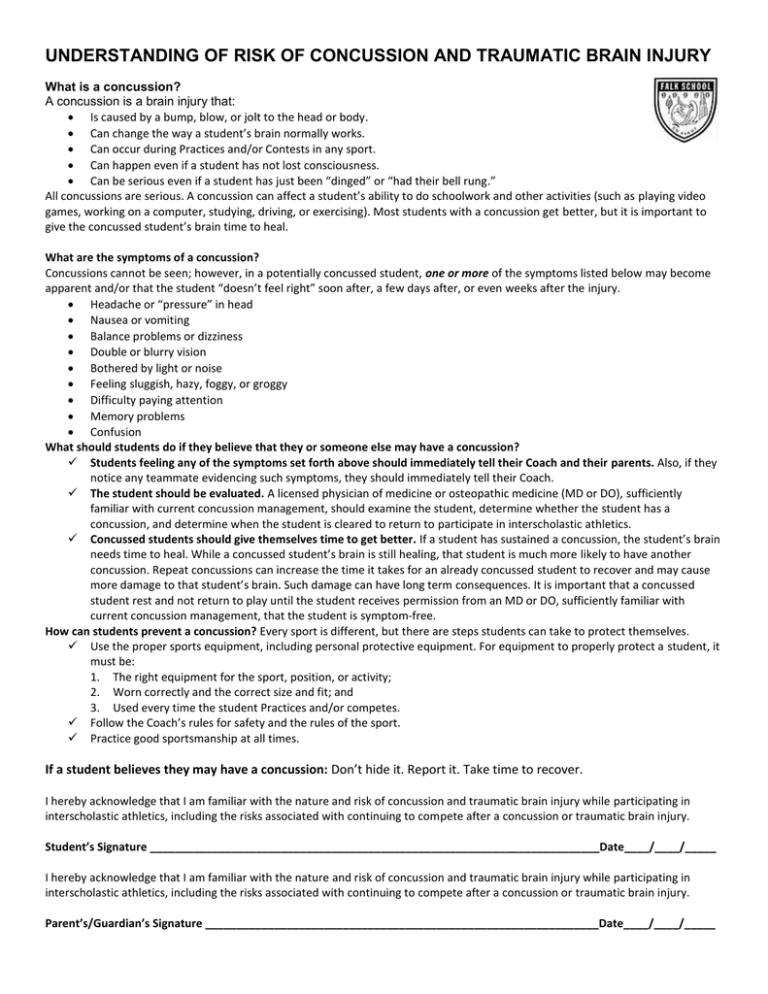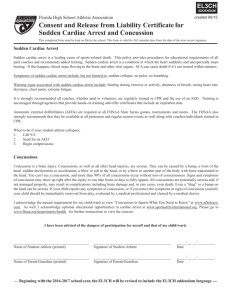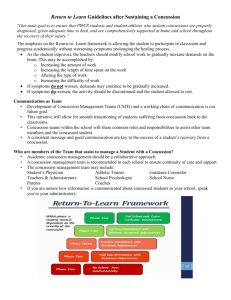UNDERSTANDING OF RISK OF CONCUSSION AND TRAUMATIC BRAIN INJURY
advertisement

UNDERSTANDING OF RISK OF CONCUSSION AND TRAUMATIC BRAIN INJURY What is a concussion? A concussion is a brain injury that: Is caused by a bump, blow, or jolt to the head or body. Can change the way a student’s brain normally works. Can occur during Practices and/or Contests in any sport. Can happen even if a student has not lost consciousness. Can be serious even if a student has just been “dinged” or “had their bell rung.” All concussions are serious. A concussion can affect a student’s ability to do schoolwork and other activities (such as playing video games, working on a computer, studying, driving, or exercising). Most students with a concussion get better, but it is important to give the concussed student’s brain time to heal. What are the symptoms of a concussion? Concussions cannot be seen; however, in a potentially concussed student, one or more of the symptoms listed below may become apparent and/or that the student “doesn’t feel right” soon after, a few days after, or even weeks after the injury. Headache or “pressure” in head Nausea or vomiting Balance problems or dizziness Double or blurry vision Bothered by light or noise Feeling sluggish, hazy, foggy, or groggy Difficulty paying attention Memory problems Confusion What should students do if they believe that they or someone else may have a concussion? Students feeling any of the symptoms set forth above should immediately tell their Coach and their parents. Also, if they notice any teammate evidencing such symptoms, they should immediately tell their Coach. The student should be evaluated. A licensed physician of medicine or osteopathic medicine (MD or DO), sufficiently familiar with current concussion management, should examine the student, determine whether the student has a concussion, and determine when the student is cleared to return to participate in interscholastic athletics. Concussed students should give themselves time to get better. If a student has sustained a concussion, the student’s brain needs time to heal. While a concussed student’s brain is still healing, that student is much more likely to have another concussion. Repeat concussions can increase the time it takes for an already concussed student to recover and may cause more damage to that student’s brain. Such damage can have long term consequences. It is important that a concussed student rest and not return to play until the student receives permission from an MD or DO, sufficiently familiar with current concussion management, that the student is symptom-free. How can students prevent a concussion? Every sport is different, but there are steps students can take to protect themselves. Use the proper sports equipment, including personal protective equipment. For equipment to properly protect a student, it must be: 1. The right equipment for the sport, position, or activity; 2. Worn correctly and the correct size and fit; and 3. Used every time the student Practices and/or competes. Follow the Coach’s rules for safety and the rules of the sport. Practice good sportsmanship at all times. If a student believes they may have a concussion: Don’t hide it. Report it. Take time to recover. I hereby acknowledge that I am familiar with the nature and risk of concussion and traumatic brain injury while participating in interscholastic athletics, including the risks associated with continuing to compete after a concussion or traumatic brain injury. Student’s Signature ________________________________________________________________________Date____/____/_____ I hereby acknowledge that I am familiar with the nature and risk of concussion and traumatic brain injury while participating in interscholastic athletics, including the risks associated with continuing to compete after a concussion or traumatic brain injury. Parent’s/Guardian’s Signature _______________________________________________________________Date____/____/_____ UNDERSTANDING OF SUDDEN CARDIAC ARREST SYMPTOMS AND WARNING SIGNS What is sudden cardiac arrest? Sudden cardiac arrest (SCA) is when the heart stops beating, suddenly and unexpectedly. When this happens blood stops flowing to the brain and other vital organs. SCA is NOT a heart attack. A heart attack may cause SCA, but they are not the same. A heart attack is caused by a blockage that stops the flow of blood to the heart. SCA is a malfunction in the heart’s electrical system, causing the heart to suddenly stop beating. How common is sudden cardiac arrest in the United States? There are about 300,000 cardiac arrests outside hospitals each year. About 2,000 patients under 25 die of SCA each year. Are there warning signs? Although SCA happens unexpectedly, some people may have signs or symptoms, such as: dizziness lightheadedness shortness of breath difficulty breathing racing or fluttering heartbeat (palpitations) syncope (fainting) fatigue (extreme tiredness) weakness nausea vomiting chest pains These symptoms can be unclear and confusing in athletes. Often, people confuse these warning signs with physical exhaustion. SCA can be prevented if the underlying causes can be diagnosed and treated. What are the risks of practicing or playing after experiencing these symptoms? There are risks associated with continuing to practice or play after experiencing these symptoms. When the heart stops, so does the blood that flows to the brain and other vital organs. Death or permanent brain damage can occur in just a few minutes. Most people who have SCA die from it. Act 59 – the Sudden Cardiac Arrest Prevention Act (the Act) The Act is intended to keep student-athletes safe while practicing or playing. The requirements of the Act are: Information about SCA symptoms and warning signs. o Every student-athlete and their parent or guardian must read and sign this form. It must be returned to the school o Before participation in any athletic activity. A new form must be signed and returned each school year. Removal from play/return to play o Any student-athlete who has signs or symptoms of SCA must be removed from play. The symptoms can happen before, during, or after activity. Play includes all athletic activity. o Before returning to play, the athlete must be evaluated. Clearance to return to play must be in writing. The evaluation must be performed by a licensed physician, certified registered nurse practitioner, or cardiologist (heart doctor). The licensed physician or certified registered nurse practitioner may consult any other licensed or certified medical professionals. I have reviewed and understand the symptoms and warning signs of SCA. ______________________________________ ___________________________________ Date____/____/_____ Signature of Student-Athlete Print Student-Athlete’s Name ______________________________________ ___________________________________ Date____/____/_____ Signature of Parent/Guardian Print Parent/Guardian’s Name PA Department of Health: Sudden Cardiac Arrest Symptoms and Warning Signs Information Sheet and Acknowledgement of Receipt and Review Form. 7/2012


